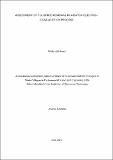Assessment of fluoride removal in a batch electro‒coagulation process
Abstract
A presence of excessive amounts of fluoride than the prescribed standards has been reported
in sources of domestic water supply around mount Meru slopes and other parts in Tanzania
while efforts to remove the excessive fluoride was carried out using various technologies and
materials. This study was perfomed to understand the fluoride removal effeciency of the
electrocoagulation technique. It has been reported that in the electrocoagulation process, ions
removal efficiency depends on the electrolysis time, voltage, pH and initial ions concentration
applied. In this electrocoagulation process, experiments were carried out to examine its
efficiency on removal of fluoride ions. The fluoride concentration tested ranged from 1.37 to
48 mg/L in both synthetic and natural waters. The voltage applied for the electrocoagulation
process ranged from 0 to 50 V while maintaining an optimal pH of 4 to 9. Experimental results
showed the removal efficiency of 90% with an optimal time of 30 minutes, at an applied voltage
of 20 V and a pH of 6 at initial concentration of 29.5 mg/L at 300 ml. The method showed
efficient removal of fluoride in water to achieve the allowable limits by the World Health
Organization and Tanzania Bureau of Standards (1.5 mg/L). At this voltage (30 V), the process
could be inferred to have the capability of treating the water and hence rendering such water
safe for use as reported previously.

